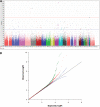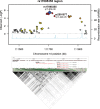Genome-wide association study identifies a susceptibility locus for biliary atresia on 10q24.2
- PMID: 20460270
- PMCID: PMC2893814
- DOI: 10.1093/hmg/ddq196
Genome-wide association study identifies a susceptibility locus for biliary atresia on 10q24.2
Erratum in
- Hum Mol Genet. 2011 Mar 1;20(5):1048. Chen, Guo [corrected to Cheng, Guo]
Abstract
Biliary atresia (BA) is characterized by the progressive fibrosclerosing obliteration of the extrahepatic biliary system during the first few weeks of life. Despite early diagnosis and prompt surgical intervention, the disease progresses to cirrhosis in many patients. The current theory for the pathogenesis of BA proposes that during the perinatal period, a still unknown exogenous factor meets the innate immune system of a genetically predisposed individual and induces an uncontrollable and potentially self-limiting immune response, which becomes manifest in liver fibrosis and atresia of the extrahepatic bile ducts. Genetic factors that could account for the disease, let alone for its high incidence in Chinese, are to be investigated. To identify BA susceptibility loci, we carried out a genome-wide association study (GWAS) using the Affymetrix 5.0 and 500 K marker sets. We genotyped nearly 500 000 single-nucleotide polymorphisms (SNPs) in 200 Chinese BA patients and 481 ethnically matched control subjects. The 10 most BA-associated SNPs from the GWAS were genotyped in an independent set of 124 BA and 90 control subjects. The strongest overall association was found for rs17095355 on 10q24, downstream XPNPEP1, a gene involved in the metabolism of inflammatory mediators. Allelic chi-square test P-value for the meta-analysis of the GWAS and replication results was 6.94 x 10(-9). The identification of putative BA susceptibility loci not only opens new fields of investigation into the mechanisms underlying BA but may also provide new clues for the development of preventive and curative strategies.
Figures


References
-
- Shim W.K., Kasai M., Spence M.A. Racial influence on the incidence of biliary atresia. Prog. Pediatr. Surg. 1974;6:53–62. - PubMed
-
- Petersen C., Harder D., Abola Z., Alberti D., Becker T., Chardot C., Davenport M., Deutschmann A., Khelif K., Kobayashi H., et al. European biliary atresia registries: summary of a symposium. Eur. J. Pediatr. Surg. 2008;18:111–116. doi:10.1055/s-2008-1038479. - DOI - PubMed
-
- Hsiao C.H., Chang M.H., Chen H.L., Lee H.C., Wu T.C., Lin C.C., Yang Y.J., Chen A.C., Tiao M.M., Lau B.H., et al. Universal screening for biliary atresia using an infant stool color card in Taiwan. Hepatology. 2008;47:1233–1240. doi:10.1002/hep.22182. - DOI - PubMed
-
- Petersen C. Biliary atresia: interdisciplinary initiatives focus on a rare disease. Pediatr. Surg. Int. 2007;23:521–527. doi:10.1007/s00383-007-1922-x. - DOI - PubMed
Publication types
MeSH terms
Grants and funding
LinkOut - more resources
Full Text Sources
Molecular Biology Databases
Research Materials
Miscellaneous

